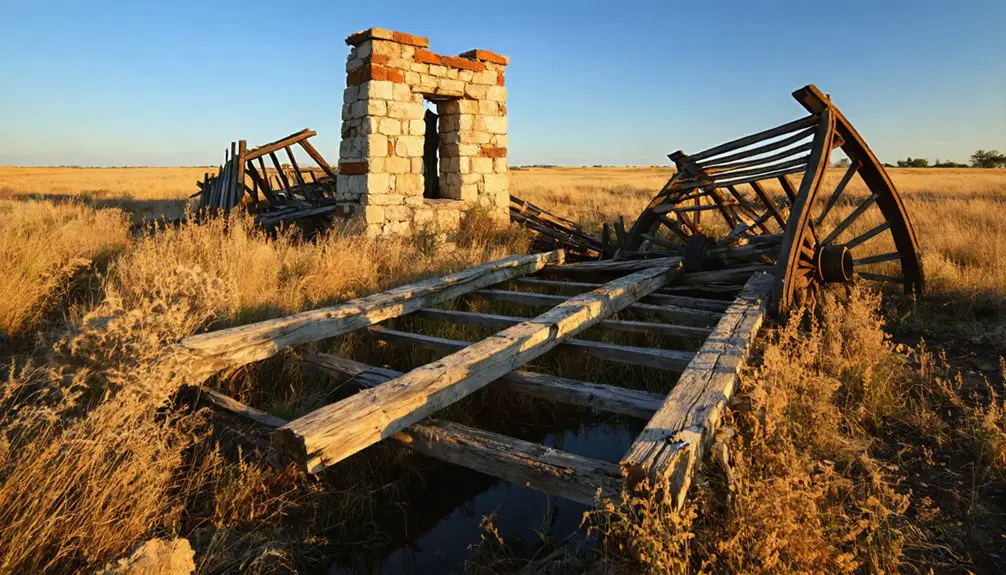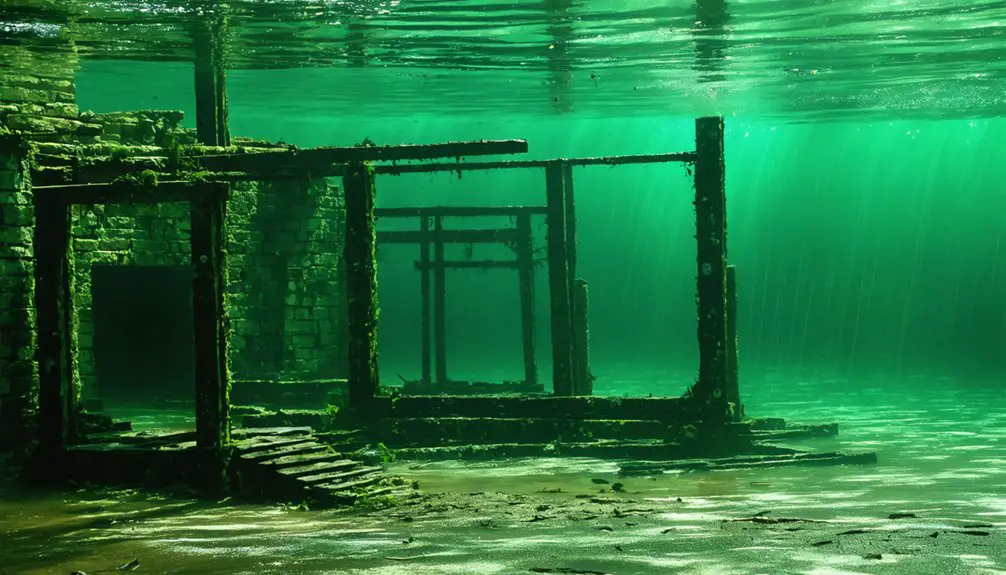You’ll find North Fork’s remains beneath Lake Eufaula, but this ghost town once thrived as an essential Creek Indian trading post established in the 1830s. Located at the confluence of the Canadian and North Fork rivers, it served as a major supply point during the 1849 Gold Rush and a Confederate stronghold during the Civil War. The town declined after being bypassed by the railroad in 1872, before finally disappearing underwater in the 1960s. Its underwater foundations hold countless untold stories.
Key Takeaways
- North Fork was a thriving Creek Indian settlement and trading post established in the 1830s near present-day Eufaula, Oklahoma.
- The town served as a crucial Confederate stronghold an
The Birth of a Creek Indian Trading Hub
When Creek Indians established North Fork in the mid-1830s, they strategically chose a location three miles east of present-day Eufaula at the convergence of the Canadian and North Canadian Rivers.
You’ll find that Creek culture thrived here, as the settlement quickly became a crucial center for economic exchange and tribal gatherings. The town, also known as Micco, gained formal recognition with a post office in 1853. The French traders had established routes along these rivers decades earlier, setting a precedent for the area’s commercial importance.
The location’s significance grew due to its position at the intersection of the Texas and California roads, making it a natural trading hub. During the 1849 Gold Rush, you’d have seen hundreds of wagons stopping here as Creek merchants supplied “Forty-niners” with horses, mules, and essential provisions for their westward journey. The establishment of Asbury Mission School in 1850 brought Methodist education to the area’s youth.
Strategic Location at River Crossroads
You’ll find North Fork Town’s strategic importance stemmed from its location at the confluence of the Canadian and North Canadian Rivers, where major trade routes like the California Road and Texas Road intersected.
The site’s history as a river crossing point stretched back to Spanish expeditions in the 1600s and French fur traders in the 1700s. The Asbury Mission school near the town helped establish it as an important educational center in 1850.
The Creek Nation established their trading hub here specifically because it served as a natural crossroads where multiple transportation routes converged, making it ideal for commerce and communication across tribal territories. Today, this historic location lies beneath Lake Eufaula, submerged when the dam was constructed.
Major Trade Routes Converge
Located at the convergence of two major trade arteries, North Fork Town thrived as a strategic hub where the Texas Road intersected with the California Road.
You’ll find this intersection played a crucial role in trade route significance during the mid-1800s, as merchants and travelers gathered to exchange goods and supplies.
During the 1849 Gold Rush, migration patterns shifted dramatically as the California Road became heavily trafficked by westward-bound pioneers. The trade markups at these crossroads commonly reached 100 percent markup on exchanged goods. Settled tribes like the Caddo established permanent trading posts along these routes.
The town’s position was further enhanced by Josiah Gregg’s trail and Marcy’s California Road, which connected to Webbers Falls and points west.
You’d see wagon trains and trading companies stopping to purchase horses, mules, and essential supplies, while the town’s location also made it an ideal staging ground for traders venturing into Comanche territory.
Ancient River Crossing Point
The North Fork of the Red River served as an essential crossing point that shaped early Oklahoma’s development through its strategic position at a natural confluence. The shallow depths at ancient crossings made this location ideal for early river navigation, allowing traders and settlers to ford before formal infrastructure emerged. The Cherokee National Council established strict regulations and licensing requirements for ferry operations by 1849. You’ll find that this strategic crossroads influenced decades of transportation development. First came the Native American traders and entrepreneurs who operated ferries, followed by toll bridges that controlled access to critical trade routes. By 1941, this vital crossing point was documented through Highway 44 bridge photography, marking the evolution of transportation infrastructure at this historic site.
Creek Nation Transport Hub
Nestled at the confluence of the Canadian and North Canadian Rivers, North Fork Town emerged as an essential transportation hub within Creek Nation territory during the mid-19th century.
You’d find yourself at the crossroads of major westward routes – the Texas Road and California Road – where the town’s transportation evolution shaped regional commerce and mobility.
During the 1849 Gold Rush, you could stock up on horses, mules, and provisions at prominent establishments like Catlett J. Atkins’ store.
The Asbury School established in 1848 under Methodist supervision served as a cornerstone of education for local residents.
The town’s economic resilience stemmed from its strategic location, serving travelers, traders, and local communities alike.
The Muscogee Creek Nation maintained strong ties to their ancestral traditions even after their forced relocation to this territory in 1836.
Ferry crossings connected you to surrounding territories, while the convergence of waterways and roads established North Fork Town’s prominence until 1872, when the Missouri, Kansas & Texas Railway‘s bypass redirected traffic to Eufaula, marking the end of its transport dominance.
Rise as a Commercial Powerhouse
Situated strategically at the confluence of the Canadian and North Fork rivers, North Fork Town emerged as an essential commercial hub in the mid-1800s.
You’d find a bustling marketplace where Catlett J. Atkins’ large store anchored the town’s trading activities, serving both locals and westward travelers. During the 1849 Gold Rush, the town’s commercial significance peaked as forty-niners gathered supplies for their journey.
Merchants and pioneers converged at Atkins’ store, turning North Fork into a vital resupply point during the California Gold Rush.
Key aspects of North Fork’s commercial dominance included:
- Major junction connecting Texas and California roads
- Vital supply point for westbound travelers and military operations
- Ferry crossings facilitating trade and transport
- Established post office solidifying its mercantile status
Despite its prosperity, transportation shifts led to economic decline when the Missouri, Kansas and Texas Railway bypassed the town in 1872, redirecting commerce to Eufaula.
Native American Political Center

North Fork Town emerged as an essential political center for the Creek Nation when Creek Indians founded it in the mid-1830s.
You’ll find that the town quickly became a significant meeting place for intertribal councils, where leaders from various Native American nations gathered to discuss political matters and forge alliances.
The town’s political significance peaked during the Civil War era when Confederate diplomat Albert Pike negotiated alliance treaties with the Creek, Choctaw, and Chickasaw nations there in 1861.
Creek Nation Political Hub
Established in the 1830s as a pivotal Creek settlement, North Fork Town quickly emerged as the region’s dominant political and trade hub for Native American affairs. Under Mikko leadership and consensus governance, the town’s strategic location at the crossroads of Texas and California Roads made it essential for intertribal relations and cultural resilience.
- You’ll find evidence of political consolidation through the town’s role in hosting numerous intertribal councils, maintaining tribal autonomy while fostering broader alliances.
- The settlement’s historical significance grew as it became a Confederate supply base and treaty negotiation site in 1861.
- The community supported critical institutions including a post office and the Asbury Mission boarding school.
- Economic shifts tied to railroad development in nearby Eufaula led to North Fork’s declining influence after 1872.
Intertribal Council Meeting Place
Building upon its Creek political foundations, North Fork Town blossomed into one of Indian Territory’s most significant intertribal council sites during the mid-1830s.
You’ll find its strategic location at the junction of Texas and California roads made it ideal for tribal diplomacy, particularly where the Canadian and North Canadian rivers meet.
The town’s prominence peaked in 1861 when Confederate commissioner Albert Pike negotiated essential intertribal alliances here with Creek, Choctaw, and Chickasaw nations.
You’ll appreciate how North Fork’s infrastructure supported these gatherings, including the Micco post office established in 1853 and Asbury Mission school.
The settlement served as both a political center and supply base during the Civil War, though its influence later declined when railroads bypassed the town in favor of nearby Eufaula.
Life During the California Gold Rush
When news of gold’s discovery at Sutter’s Mill spread in 1848, over 300,000 people flooded into California during the next seven years, transforming the region’s demographics and economy.
The gold rush impact rippled through every aspect of life, as miners faced harsh conditions and mining challenges in their quest for riches.
- You’d find yourself living in rough, temporary camps where lawlessness prevailed until proper towns emerged.
- Your daily work would involve backbreaking labor, from panning streams to operating complex sluicing systems.
- You’d pay extremely high prices for basic supplies, as merchants capitalized on the massive demand.
- You’d witness rapid changes as boomtowns transformed from lawless camps into structured settlements with banks, stores, and government.
The gold fields yielded about $2 billion by 1849, peaking in 1852 with $81 million extracted in a single year.
Civil War Era Significance

While California’s gold rush transformed the American West, North Fork Town emerged as a pivotal Confederate stronghold in Indian Territory during the Civil War.
You’ll find the town’s strategic negotiations began in July 1861 when Confederate commissioner Albert Pike secured Native alliances with Creek, Choctaw, and Chickasaw tribes. The town’s location at the fork of two rivers made it essential for military logistics, supporting Confederate operations throughout the territory.
Intertribal relations grew complex as Native peoples divided their loyalties, leading to dual tribal governments and internal conflicts. The cultural impact of these alliances shaped the region’s historical significance until 1872, when the Missouri, Kansas and Texas Railway bypassed North Fork Town, triggering its economic decline and eventual transformation into a ghost town.
The Railroad’s Transformative Impact
As the Missouri, Kansas and Texas Railway charted its course through Indian Territory in 1872, the decision to bypass North Fork Town sealed the community’s fate.
The railroad development established a depot at present-day Eufaula instead, triggering a swift economic transformation that would reshape the region’s landscape.
You’ll find this dramatic shift reflected in these key changes:
- Businesses rapidly relocated from North Fork Town to Eufaula
- The Micco post office closed in 1873, marking the town’s decline
- Commerce and population shifted to the new railroad hub
- The original townsite eventually vanished beneath Lake Eufaula
The railway’s impact wasn’t unique to North Fork Town – across Indian Territory, railroad access determined which communities would thrive and which would fade into history, reshaping settlement patterns and trade routes throughout Oklahoma.
Underwater Legacy of Lake Eufaula

The vast waters of Lake Eufaula claimed North Fork Town in the late 1960s when federal authorities completed the Canadian River impoundment project.
Today, you’ll find a submerged history beneath the lake’s surface, where building foundations and old roads rest silently on the lakebed. When water levels drop, you can catch glimpses of this underwater archaeology – remnants of a once-thriving Creek tribal meeting site and crossroads of the Five Civilized Tribes.
While authorities relocated key structures and cemeteries before the flooding, much of North Fork’s physical legacy remains underwater.
Local legends of Spanish explorer routes and buried treasures add mystique to the submerged town site. You can still connect with this history through relocated artifacts, historical markers, and stories passed down by former residents and their descendants who gather to keep North Fork’s memory alive.
Preserving North Fork’s Cultural Memory
When North Fork Town disappeared beneath Lake Eufaula‘s waters, historians turned to multiple preservation methods including written accounts from early settlers, Creek tribal members’ oral histories, and historical society documents to maintain its legacy.
You’ll find detailed records of the town’s cultural significance in Carolyn Thomas Foreman’s historical narratives, which capture the vibrant intersection of Native American and colonial life during North Fork’s peak years.
Today’s preservation efforts combine traditional documentation with community education programs that share North Fork’s story through digital archives, relocated artifacts, and local historical society initiatives.
Historical Documentation Methods
Preserving North Fork’s cultural legacy relies on diverse documentation methods that span multiple disciplines and time periods. Through careful archival research and document preservation efforts, you’ll find a rich tapestry of historical records that tell the story of this once-thriving community.
- Official records from Indian Territory and Oklahoma state offices provide crucial data through land deeds, trading post permits, and census information.
- Creek Nation archives reveal council meeting minutes and treaty documents highlighting North Fork’s significance as an intertribal gathering place.
- Historic maps trace North Fork’s position at major crossroads, showing Spanish expedition routes and fur trading paths.
- Archaeological surveys conducted before Lake Eufaula’s creation recovered artifacts and documented structural remains, while cemetery relocation records preserve essential genealogical connections for descendants.
Oral Traditions Today
Beyond written records and physical artifacts, North Fork’s living history continues through vibrant oral traditions that span generations of Creek Nation descendants.
You’ll find these stories shared during tribal councils and cultural gatherings, where elders pass down accounts of the town’s role as a Creek Nation crossroads and trading post. Through oral history, you’ll learn about Spanish expeditions, Fox and French trappers, and the Texas Trail’s significance.
Today’s storytelling techniques include traditional Creek songs, chants, and language expressions that preserve memories of local leaders like Chief Samuel Checote.
While Lake Eufaula’s waters now cover the original town site, community workshops train younger members to collect and share these narratives, ensuring North Fork’s cultural memory endures despite modern challenges of urban migration and language loss.
Community Education Initiatives
Through dedicated community initiatives, North Fork’s cultural memory finds new life in educational programs that build upon the town’s rich Native American heritage.
You’ll discover vibrant programs designed to preserve and share the area’s cultural heritage, from youth camps on historical school grounds to partnerships with tribal historians for authentic storytelling and artifact conservation.
- Experience heritage education at former sites like Schlaco Indian Agricultural School, where community-led programs connect you to Creek Nation history.
- Participate in cultural preservation events that blend traditional knowledge with modern learning approaches.
- Explore archived materials from the Western History Collection’s 1,200+ sources.
- Join tribal programs focused on fostering resilience and identity among Native youth through hands-on community engagement.
Lost Towns of Indian Territory
During the era of Indian Territory, countless communities emerged and vanished across what would become Oklahoma, with North Fork Town standing as a prime example of these lost settlements.
You’ll find North Fork’s forgotten histories deeply woven into Oklahoma’s cultural fabric, from its origins as an 1823 trading post to its role as a crucial crossroads where indigenous narratives intersected with settlers’ dreams.
The town’s legacy preservation continues through stories of community resilience, despite being submerged beneath Lake Eufaula.
Cultural artifacts occasionally surface during lake drawdowns, reminding you of the economic shifts that transformed this region.
From its days as a bustling hub of Creek Nation commerce to its eventual abandonment, North Fork’s story mirrors many ghost towns that disappeared as Indian Territory evolved into modern-day Oklahoma.
Frequently Asked Questions
What Daily Life Activities Took Place in North Fork’s Households?
You’d spend your days doing daily chores like cooking, cleaning, and mending, while hosting family gatherings for storytelling, prayer, and communal meals, alongside farming, crafting, and trading with neighbors.
How Many People Lived in North Fork During Its Peak?
During the peak era, you’d find about 300 residents thriving in the bustling community, with population growth driven by its role as a stagecoach stop and tribal meeting place.
What Happened to the Original Artifacts From North Fork Town?
Like scattered treasures in time’s flood, you’ll find North Fork’s artifacts were dispersed when Lake Eufaula submerged the town. Some artifacts’ historical significance lives on in private collections, while others were lost underwater.
Were There Any Famous Outlaws or Notable Figures in North Fork?
You won’t find specific outlaw legends tied directly to North Fork, though William Nero, Delilah Drew, and Creek Chief Samuel Checote were historically significant figures who shaped the town’s development and commerce.
What Types of Buildings and Architecture Existed in North Fork?
After an 1887 fire destroyed 90% of structures, you’d find simple wooden buildings dominating North Fork’s historical architecture – from general stores to schools, with basic building materials reflecting frontier practicality.
References
- https://www.porchesandpastures.com/history-of-the-lake-eufaula-area/
- https://www.lakeeufaula.com/news–travel–Is-There-A-Ghost-Town-Under-Lake-Eufaula/7265
- https://www.okhistory.org/publications/enc/entry?entry=GH002
- https://z94.com/lost-oklahoma-towns-underwater/
- https://www.okhistory.org/publications/enc/entry?entry=NO011
- https://okgenweb.net/~okmcinto/egs/2007 Centinneal Presentation/Eufaula summary/v029p079.pdf
- https://www.nps.gov/parkhistory/online_books/regional_review/vol2-1b.htm
- https://www.okhistory.org/publications/enc/entry?entry=FU004
- http://files.usgwarchives.net/ok/jackson/history/jacksonhistory.txt
- http://okietreasurehunter.blogspot.com/2009/04/north-fork-town-oklahoma.html



